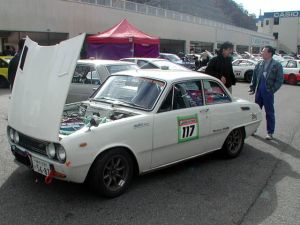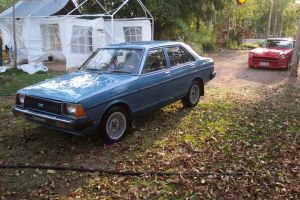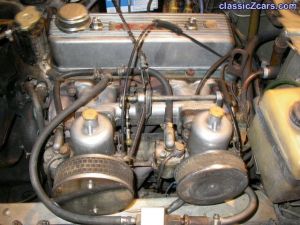Everything posted by Murph
- Hazard lights in Aussie Zeds
-
Hazard lights in Aussie Zeds
Not if they weren't an original fitment.
-
Took my Z drifting the other day...again
That's one mighty single legger!
-
Hazard lights in Aussie Zeds
Which ones had them and which didn't. My early 260 2-seater doesn't and nor did my 260 2+2 parts car. I've noticed that all the wiring is there under the center console, so does that just mean it'd be a case of plugging in the switch (if I source one)? After a little incident today I've decided it'd be a damn good idea to have them in my zed. My alarm/imobiliser has been playing up lately, it'll just die, not letting you start the car. Well....the car stalled this afternoon at a large and busy intersection, in peak hour traffic....and all just as it started raining......and of course, it wouldn't let me start it again. It would have been nice if I could have hit the hazards to let people know there's a problem. Luckily another driver gave me a hand as I got out and started to push it around the corner and off the road. Damn some people were rude though...like some soccer mum in her 4WD giving me a dirty look when I signaled her to stop to let me get it off the road.....rather than her blocking me in. :stupid:
-
Building the Ultimate Response RB!!!
Mate, there's no two ways about it.....this wont even come close to working. The AC system would only be able to remove a fraction of the heat that will be delivered to the IC. I doubt such a system would even be able to maintain less than ambient intake temperatures while cruising. Let just be fanciful and say you had a compressor and aircon system that was large enough to be capable to remove the heat, it'd require that much power from the engine to turn it, that the gains from the cooler intake air would pale in significance. I could sit down and spell out all the theory for you to prove it, but it's pointless. As Inf said, there's no free lunch. You can't just make power out of nothing. What you describe is as good as the perpetual motion machine! If you got this system to work (and broke the laws of thermodynamics, among others), you'll be a very famous man. Sorry to sound harsh....but that's how it is. You might like to be more specific as to what cars exactly you're refering to. Any can that's raced on a track for a decent length of time would most likely be better off with an air-air core as I explained above. For street use, spint racing or motorkhana, water-air is great. If you hardly ever boost your car on the street, then good on you champ. I'm talking about the average joe that does give it a hit here or there....go out for a play with the mates. Yes, water-air will weigh more air-air, but in it's favour: •The cores used are much smaller, we're talking both cores combined will be smaller than an equivalent air-air core. •It allows for a very short intake tract. Again, great if you want response. •Simplified piping. You wont need 3-4" piping running to the front of the car, just a ~1.5" water pipe. •Smaller core to mount at the front of the car, good for car that don't have much room up front and don't want a custom front bar. ...and that's just the looking at the physical setup of the system, not even looking at its cooling efficiency. •Water to air will keep a cooler temperature for longer (up to a point) •It wont instantly heat soak when there's no air flow. This makes it ideal for drag cars. They'll heat soak the an air-air core while doing the burnt out, greatly reducing the cooling ability of the core until they're they start getting good air flow past half track. A water to air system could store that entire quantity of heat in the water without getting anywhere near the temperature you'll see with the air-air core. A good example is my mates SIV RX7 which he races in the local sprint racing series (typically around 5min on the track at a time). He built his own water-air setup, using two stock RX7 intercoolers in parallel, enclosed within a water bath (small, light, flows well and will effectively cool). The radiator used is an aluminium radiator from a small car, it's only about 1.5cm thick (so is easy to fit behind the stock bumper) and is also very light. This setup was a fraction of the cost of a large air-air core, intercools more effectively, allows for very efficient use of space, allows the stock bumper to be kept and has a very short intake path giving excellent throttle response (exactly what you want in sprint racing). This is producing ~200rwkw btw. Mind you, there's nothing wrong with air-air intercoolers, they're by far the simplest, no fuss solution.....but they're a long way from being the best.
-
Sun/targa roof possible?
Oh it will be mine...yes it will!
-
Building the Ultimate Response RB!!!
I just want to point out that my explanation above is a rather simplified version of how it all works. So any other engieers out there....don't pick it to shreds. The problem here is the AC system simply wont be able to shed the quantity of heat that you're trying to pull out of the inlet air stream. This is where you again need to go to a water/glycol etc - air based system. You need to have smothing that can quickly absorb all that heat. With such a system, if you refrigerate the water then you'll be able to get some pretty low intake temps for a limited time. It'd probably work out fairly well for street use. But keep in mind: •extra weight •power being sapped by the compressor •greater fuel use •and it'll only keep temps down for a limited time If you went for a high speed blat down the highway, or went to race on a track, you'd have that water up at crazy high temps in no time....the ac compressor simply wouldn't keep up. Maybe if you had it bypass the water from the cooled core to a radiator when the water temp raises to above ambient. Too much fuss for my liking though. There was talk of this sort of setup being used on some yank SUV a while back....don't know if they ever did it though. I also remember reading about such a setup someone had installed in their car. I think they found that it simply tool the ac system far too long to cool the required quantity of water.
-
Building the Ultimate Response RB!!!
I can't say I've every heard of anyone using a water-air setup without a radiator? Other than purpose built drag cars etc... They are actually a great idea for the street. The amount of heat that can be shed from a large air-air core will be greater than (what is typically a much smaller) a radiator....but that isn't all that important. With an air-air core, the relatively small volume of metal in the core can only absorb a small amount of heat without it's temperature raising greatly. Heat transfer from the core to the ambient air is largely a function of the temperature difference of the which the heat transfer is occuring and the heat capacity of the medium to which it is being transfered. The ambient air blowing through the core has a low heat capacity, so simply can't remove the required quantity of heat until there is a large temperature difference between the core and the ambient air. With a water-air setup, the water has a much much higher heat capacity, so you have a greater heat transfer rate from the core to the water, at a smaller temperature difference. On the street you wont be boosting too often, so you don't need a particularly large radiator to be able to shed the heat from the water, over a longer period of time (without any great rise in water temp). This is their downfall for circuit racing and such where you're on the power almost continiously. You'd esentially need a radiator with the same surface area as the air-air core to be as effective.....which makes for larger, heavier system that's no more effective than a large air-air core. To sum it up, the main point is that a water-air setup has a much greater capacity to store heat than an air-air setup. As such, on the street you'll be seeing lower intake temps with the water-air intercooler. Of additional advantage, the cores needed for the water-air system are much smaller making for a much more space efficient setup and also allowing a very short (read RESPONSIVE) inlet tract.
-
Sun/targa roof possible?
Quite right there! It'll be a torque steering monster. The that's building it though, he's pretty experienced with such things, so I'm pretty sure he researched it all well and know what will be required to make it reliable at those power levels.
-
Sun/targa roof possible?
On the topic of the NX, a mate has just bought a NXR that's had a SR20DET conversion. It's currently spitting out 160kW @ wheels, and he's aiming for around 200 eventually.
-
update on our project
I emailed my mate about the ADR file, here's his response: Anyhow, I'll send you the ADR file whenever simon sends it to me. My advice would be to do some reading up on the ztech forum to get a gist of how the whole process of remapping the stock ECUs works. It might be worth seeing if you can find a workshop in your area that actually has all the gear to do it, namely a real time emulator. Otherwise there is some cost in buying all the gear yourself. As for adapting the ECCS ECU, it shouldn't be a big hastle if your reasonably confident with wiring. I know there are plenty of people that adapt the RB20 ECU to the RB25s, as the RB25 ECU isn't easily programable. It would really be a matter of getting the ECCS ECU, engine loom and sensors, then plugging that all into the NICS engine. One catch would be that you wouldn't have anything to control the NICS anymore. You'll notice the inlet manifold has two runners per cyliners. The NICS system closes one of the two runners as low revs, increasing intake air velocity, giving greater torque....something you'll be wanting! You could make up a pretty simple electronic circuit to control it however.....and until you do that you just wire it fully open. I'd guess the mapping for the ECCS wont be exactly right for the NICS, but would have to be close. Either way you could just pull the fuel and ign maps off the NICS EEPROM and put them on the ECCS EEPROM quite easily. If there's anything else you want to know, just give me a yell. If I don't know it, my two mates that play with this stuff will.
-
Took my Z drifting the other day...again
The whole diff or just the center? I've never heard of anyone using a patrol diff. Any info on fitting one to a zed?
-
Building the Ultimate Response RB!!!
A question for the Americans. Over here in australia while most people are still using large air to air ICs, there seems to be a trend towards using water to air ICs. Is this happening over in the US too? Really, it's an excellent idea for street, drags or sprint type racing.....maybe not so good for longer races though.
-
headlight relay upgrade harness's for sale
Arrh! The plugs are oval! ......and they're both different! Gee I hate my car at times! I'll have to have a closer look tomorrow and work out what the hell is going on and take a few pics.
-
Building the Ultimate Response RB!!!
If you were on the power for exteneded periods AND your intercooling system could maintain low temperatures for that period of time, you could freeze your throttle body open. But over a short period of time, it's unlikely to be a problem. There are plenty of drag cars around using intercoolers packed in dry ice that will maintain ~ 0 deg c over a full pass.
-
headlight relay upgrade harness's for sale
Dave, any chance you'd make one up to suit a RHD 260Z? AFAIK the only difference would be the battery position. If that's a possibility, I'm quite interested.
-
Amp Draw I can safely add
If you do end up using a thermofan, just make sure you're getting the power directly from the battery and not any other source on the loom. I do agree with the others however, that sticking with the clutch fan would be wise.
-
umm?
Hell yeah. Love the looks of the Bellet. There's a VERY rusty 2 speed auto example sitting out the back at my mates place. If it hadn't rusted away so much I would have rescued the thing by now.
-
skyhigh
-
My new Datto!
It's a shocker hey. The section of the roof that's up is a tarp we had lieing around.The sides are all ripped up and just blow around now. Pretty disapointing.
-
update on our project
Yes the ECU is a more primitive design than that laster ECCS ECUs. IIRC the EEPROM is half the size of that used in the ECCS ECUs. However, it is remappable using the same software and techniques as the later ECUs. We had done this with my mates NICS ECU without any dramas. The main problem is that we haven't been able to find an ADR file for the NICS (points the software to the location of the maps and other constants in the EEPROM). So the lads basically went hunting through the file themselves and have found most things. Simon has sold the car now so development of the ADR file has stopped, but if you're interested, I can get you a copy. It at least covers the important things like fuel, ign and VQ maps. Alternatively you could adapt the RB20 ECCS ECU. I'd imagine the mapping wouldn't be too far off.
-
Took my Z drifting the other day...again
Open diff + sideways = BAD Get yourself an LSD, or if you can't afford that get spare diff/centre and weld it. Will get the rear end out much more easily, but more importantly, it will be much more predictable.
-
CSP311 Silvia
-
update on our project
Should be good fun! Despite people always bagging out on the NICS, they're no bad thing. Their biggest problem was the tiny tiny turbo. Ditch that and you're laughing. A mate of mine had a NICS RB20 in his R31 with a HT-18 (SIV RX7 turbo)....it was spitting out 180rwkw on 13psi.
-
Lambo doors....
That's what I'm talkin' 'bout!!!








